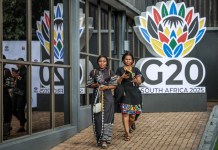“Sindh is a country since the times of Raja Dahir in 711 which was conquered by the Arabs. At that time it was Sindhudesh, we are claiming the same Sindhudesh.
A massive pro-freedom rally recently rocked Pakistan’s Sindh region with people holding placards of the world leaders, including Indian PM Narendra Modi and the US President-elect Joseph Biden, among others, seeking separate homeland ‘Sindhudesh’ for the Sindhi population in the country.
The rally was organized to mark the 117th birth anniversary of GM Syed, who is considered the founding father of ‘modern Sindhi nationalism’. The participants of the rally were seen holding pro-freedom slogans in Syed’s hometown Sann in Jamshoro district of Sindh.
The Sindhis consider themselves descendants of the natives of the Indus Valley Civilization, whose society was shaped by the different religions and cultures in the region in the last 5000 years.
The Sindhi nationalists claim the province was illegitimately occupied by the British Empire and then delivered to the Islamic nation of Pakistan in 1947 against the wishes of its population.
According to the memoirs of the 19th-century British traveler Richard Burton, Sindh province was one of the calmest regions of British India, with its own unique blends of faith. He described the province as a land characterized by many shrines of Sufi saints; which were attended in large numbers by both Muslim as well as Hindu natives of the region.
According to Burton, Sindhi Muslims were somewhat different in their beliefs and rituals from the Muslims of the rest of India. Even the Hindus of Sindh, according to him, were different since their faith was more influenced by Buddhism.
The partition of 1947 witnessed largescale violence between Hindus, Muslims, and Sikhs. However, Sindh was the only region that remained peaceful, because of the inherent qualities of pluralism and harmony that existed in the Sindhi society for centuries.
After the creation of Pakistan, “the Pakistani state began in earnest its long-drawn project to cut through the country’s ethnic complexities by constructing and then imposing a monolithic narrative of Pakistani nationhood,” according to Dawn.
The assault attracted the disdain of the nation’s ethnicities, who rejected the imposition of the supposed nationhood on them, who believed the idea contradicted their belief systems and their faith which they had inherited.
The Sindhis believe the state onslaught threatened their culture, language, and pluralistic values. Their fight for a separate homeland has been going on ever since 1947, however, it was given prominence by GM Syed in the 1970s.
“Syed’s works gave Sindhi identity a historical and religious context that also helped shield the Sindhi society from being affected by the disastrous sectarian and extremist fall-outs of the various religious experiments conducted by the state and governments of Pakistan,” according to the Dawn article.
The demand for freedom is growing among the Sindhi population in recent times, with many nationalist parties leading the struggle whose leaders have either been jailed or exiled in recent years. The pro-freedom rally on Sunday happened under the banner of one such organization, calling itself the Jeay Sindh Freedom Movement (JSFM).
The founder of JSFM, Zafar Sahito, who is living in exile in New York, spoke to The EurAsian Times about the demands put forth by his organization.
“Sindh was an independent country when the British attacked in 1843, and when they left, they should have given us freedom. It was our right. Pakistan was created by the British to serve their interests.
“Sindh is a country since the times of Raja Dahir in 711, which was conquered by the Arabs. At that time it was Sindhudesh, we are claiming the same Sindhudesh (now),” he adds.
According to historians, Raja Dahir Sen was the last Hindu ruler of Sindh, which is now in Pakistan. In 711 CE, his kingdom was conquered by the Ummayad Caliphate, led by the Arab General Muhammad bin Qasim.
“In 1971, GM Syed, our founder, put the foundation stone of our Sindhudesh movement. He was a good friend of Sheikh Mujibur Rahman. GM Syed realized that if Bangladesh can get freedom from Pakistan then why not Sindhudesh? The proponents of Sindhudesh have to get a separate identity for themselves,” says Zafar.
The Sindhis also complain of widespread discrimination in the allocation of power and resources when compared to other provinces. “Sindh generates 63% of the revenue, while all the power rests in a province of Punjab, which has a 65% population in the army. Also, the language imposition of Urdu has happened, although we only speak Sindhi, which has resulted in our own languages fading out of our society,” he adds.
So, why is there a sudden surge in separatist voices in the region? Zafar says the proliferation of social media has helped them reach their voices across the globe. The mainstream media in the country has always been barred from carrying the news about the pro-freedom movement, but the rise of the internet has given them a voice. He says their struggle is gaining support from many quarters.
The pro-freedom sentiment in Pakistan’s Sindh is widespread and many people don’t speak out because of the fear of the government action. Veengas, a Sindhi journalist, told The EurAsian Times that people have sometimes gone missing for speaking out on the issue. She says the rallies have happened in the past but didn’t receive any coverage before.
“The several provinces in Pakistan (Sindh, Balochistan, and KP) that have faced discrimination realize that they were being exploited by the Center. The idea of freedom gained momentum after cases of government repression surged against activists and leaders recently,” Veengas says.
The widespread Chinese intrusion in Pakistan has accentuated the demand for independence in Sindh, Zafar says.
“China is being allowed to exploit our natural resources, take over our industry, and farmlands without any hindrance. Sindh is being deliberately selected for industrialization by Pakistan to have its demography and resources shattered and exploited. Sindhis will soon be Chinese slaves,” he says.
Zafar says his organization is lobbying with different global organizations and groups to get them to support the independence of Sindh and expose Pakistan’s repressive policies towards its minorities and various ethnicities. He says he will continue to work for the freedom of Sindh from Pakistan, and he’s determined to achieve that goal.
The Sindhis have been fighting for a separate homeland for themselves for decades, now the movement is gaining global attention. With the growing number of Sindhi nationalist leaders, activists, and students being disappeared, jailed, or tortured by the Pakistani authorities, the local population is hesitant to speak up for now. Although the sentiment of independence remains seeped in their collective conscience.




